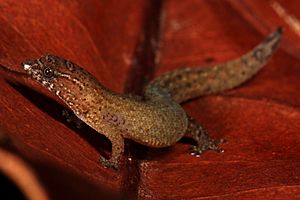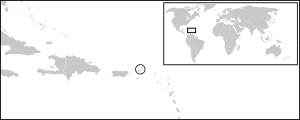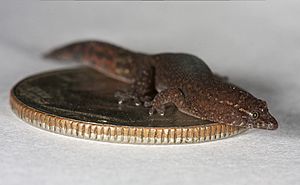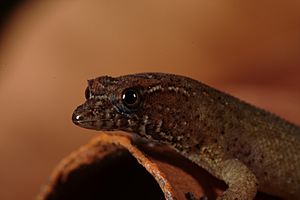Virgin Islands dwarf sphaero facts for kids
Quick facts for kids Virgin Islands dwarf sphaero |
|
|---|---|
 |
|
| Conservation status | |
| Scientific classification | |
| Genus: |
Sphaerodactylus
|
| Species: |
parthenopion
|
 |
|
| General distribution of Sphaerodactylus parthenopion |
|
The Virgin Islands dwarf sphaero is a tiny type of gecko. It is one of the smallest land animals with a backbone! You can only find it on three of the British Virgin Islands: Virgin Gorda, Tortola, and Moskito Island.
Scientists discovered this gecko in 1964. They think it's related to another tiny gecko from nearby Puerto Rico. Even though it lives in dry areas, this dwarf sphaero likes to hide in moist spots under rocks. This helps it stay hydrated because its small body can lose water easily.
This gecko is usually deep brown with some darker spots. It's about 18 mm (0.71 in) long, which is almost as small as a U.S. dime. It weighs very little, only about 0.15 g (0.0053 oz). It has lighter stripes behind its eyes and on its neck. Males and females look similar, but females are a bit bigger. If its tail breaks off, it can grow back! Scientists don't know much about how many there are or how they live.
Contents
Discovering the Dwarf Gecko
The Virgin Islands dwarf sphaero was found in the summer of 1964. A biologist named Richard Thomas discovered it during a trip to Virgin Gorda in the British Virgin Islands. He found the first adult female gecko on a hillside above Pond Bay. He collected eight more geckos from Virgin Gorda to help describe this new species.
This gecko belongs to a group called "dwarf sphaeros" or "dwarf geckos" (genus Sphaerodactylus). It's known for its tiny size and special scale patterns on its head. Its scales are small, have a ridge (keeled), and overlap like roof tiles (imbricate) on its back. It's usually a dark color on top and doesn't have bumpy scales in the middle of its back.
Even though they look different, the Virgin Islands dwarf sphaero might be related to S. nicholsi, another very small gecko from Puerto Rico. Another gecko, S. townsendi, lives between these two areas. This suggests that S. townsendi appeared after the Virgin Islands dwarf sphaero and S. nicholsi became separate species.
What Does It Look Like?
The Virgin Islands dwarf sphaero is one of the smallest amniotes (a group that includes reptiles, birds, and mammals). It's about 18 mm (0.71 in) long from its snout to its vent (the opening at the end of its body). It weighs about 0.15 g (0.0053 oz). The only known amniote that is smaller is S. ariasae, which is about 16 mm (0.63 in) long.

This gecko is usually deep brown on its back and legs. It often has tiny patterns of darker scales. It has a line of colored scales in front of its eyes, but this can be hard to see. A narrow, dark-edged, yellow-brown stripe goes from behind each eye, across its temple, and fades near the back of its head. On top of its head, behind the eyes, there's an almost oval-shaped, dark-edged, yellow-brown bar. This bar sometimes connects with the stripes behind the eyes. The dark brown scales from its back extend to its belly, where they fade out. Its belly is light grey or cream. Its tail is mostly yellowish-brown with some darker spots or lines. Its throat has faint to clear lines of light scales running sideways.
Males and females have the same colors, but females are usually a bit larger. Females are about 18 mm (0.71 in) long, while males are about 16 mm (0.63 in). Its snout is not too long and is blunt. Its tail can grow back if it breaks off.
The scales on its back are generally small, pointed, ridged, and flat. The scales on its throat and chest are also ridged. Bumpy scales are found on top of its head and the front of its neck. The scales in the middle of its back are not bumpy. On the top of its tail, the scales are pointed, ridged, and flat. On the underside of its tail, the scales are smooth and round. The scales on its belly are also round, smooth, and overlap.
Where Does It Live?
The Virgin Islands dwarf sphaero was first found only on Virgin Gorda. But now, it has also been seen on Tortola and Moskito Island. Some people think it lives all over the British Virgin Islands. However, the first scientists who looked for it didn't find it on other islands like Anegada or in the United States Virgin Islands.
This gecko seems to like dry, scrubby forests with cacti and thorny bushes on rocky hillsides. It has been found near the sea, but not on beaches or in piles of rotting plants. It doesn't live in the same places as the larger big-scaled least gecko (S. macrolepis), even though they share the same general area. The dwarf sphaero doesn't "swarm" in leaf litter. Instead, it's usually found hiding under rocks, which are moist spots in its dry home.
How Does It Survive?
Scientists don't know much about how the Virgin Islands dwarf sphaero lives and behaves. Because it's so small, it has a large surface-area-to-volume ratio. This means it can lose water very quickly. Scientists have studied it to understand how it survives in its dry home.
Unlike some desert lizards, this dwarf sphaero doesn't have special ways to stop water loss. It loses water at a similar rate to lizards from wetter places. Because it's so small, it loses water 70% faster than the larger big-scaled least gecko that lives in the same area.
So, how does it survive? It lives in humid (moist) microhabitats, like under rocks, in its dry environment. It also adjusts its reproductive cycle so that baby geckos hatch when there's the most rain. And it reduces its activity during the driest parts of the day.
Protecting This Tiny Gecko
It's hard to know how many Virgin Islands dwarf sphaeros there are because they are so small and blend in well. They are considered "moderately common" but are difficult to find. Their home range in the British Virgin Islands seems limited, and new buildings could affect them.
In 2011, the Virgin Islands dwarf sphaero got international attention. Sir Richard Branson announced plans to bring lemurs (endangered animals from Madagascar) to Moskito Island. He wanted to help them breed there for conservation.
However, many biologists and conservationists worried about what the lemurs would do to the island's native animals, especially the dwarf sphaero. They called it "one of the world’s rarest lizards." People feared the lemurs, which can eat many things, might harm the geckos. Other concerns included whether the lemurs would be healthy or bring new diseases.
Sir Richard Branson said that lemurs mostly eat plants and would rarely eat geckos. But he listened to the concerns. He decided to keep the lemurs in an enclosed area while experts studied the geckos more. He promised that if the studies showed a real risk to the geckos, the lemurs would stay enclosed.
See also
 In Spanish: Sphaerodactylus parthenopion para niños
In Spanish: Sphaerodactylus parthenopion para niños



